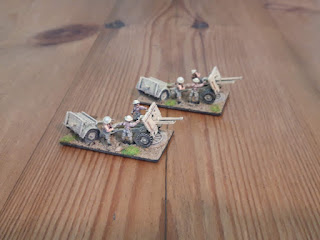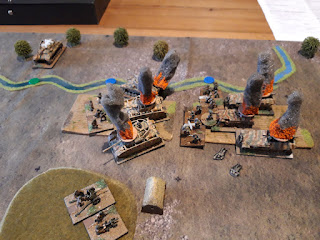Another Friday and another large scale gaming day. We had hoped to play outside but what passes for 'summer' here was a bit wet for that. So inside the Masonic Hall we went.
Gumbinnen was one of the opening actions of the First World War, the ill fated German attack in East Prussia. We've gamed it several times before, but never in 54mm.
View from the west. The rail line runs due east. Ingerburg is closest the camera, and Gumbinnen is the town in the middle. Goldap is off in the distance on the top right. The playing area is about 20' x 20'.
Prussians start to assemble. The 54mm toys are from Tim and Lloyds collections.
A Prussian Reserve Brigade of two Regiments. Each Regiment has 20 figures and it also has an artillery battery, supply column and HQ. These are my old Funny Little Wars 'Vulgarians' in 1870 Prussian uniforms. German reservists wore dark blue in 1914,
In all the Germans had four infantry divisions, an infantry brigade and a cavalry division for this game.
This is the German Corps HQ. A very fine set of beautiful metal figures belonging to Lloyd. As I'm playing Von Mackenson, one of them is me.
The German objective is to maintain control of Gumbinnen and to destroy or rout two Russians divisions. Well I'm sure that will be straightforward.
The Russian Army HQ looks far more dubious!
Three German infantry divisions. That is quite a lot of stuff.... Pete and Andrew were my divisional commanders while I ran things for the Corps.
We were honoured to have PHW, the author of Funny Little Wars attending, and he was trying out some new logistics rules to be administered by the Corps Commanders. It certainly gave me plenty to do during the game, as I very deliberately didn't push any toys around.
The Russians also have a huge amount of stuff, all still apparently in boxes.
The forces are originally concealed, with each Regiment represented by playing cards. Our lead unit (2nd Div) has just made contact with the Russians northeast of Gumbinnen.
This rather unpleasant looking horde of Russian cavalry has also appeared.
The Russians laboriously deploy into line from their march columns while our guys plink away at them at long range. With hindsight, we'd have been much, much better off digging some trenches at this point.
The Russians take Goldap.
View from the south. Our guys start to deploy against the Russians in and around Goldap. Most of our units entered several turns after the Russians, with the preponderance south of Gumbinnen. My plan was to hold Gumbinnen with two divisions, then outflank the Russians on the right with two more. The Reserve Brigade would shore up up the line and the cavalry would screen the north.
These Germans are supposed to line up and link up with their pals deployed east of Gumbinnen.
North of Gumbinnen things aren't going so well. The Russians charge our attenuated line. If only we'd dug some trenches instead of wasting all that ammo on long range rifle fire...
Somehow my divisional commanders have managed to leave a huge gap between Gumbinnen and Goldap. We've had to commit one the reserve divisions to fill it. A good job given the number of Russians heading in the that direction.
Goldap is thoroughly screened off anyway. We've still got one division left to outflank them on the right.
Gumbinnen is held by the 2nd Div Divisional HQ and artillery! They have made a fair dent in the massed Russian infantry, but there are an awful lot of Russians. The rest of 2nd Div are apparently lying dead in the fields north of the town.
One of our divisions assaults Goldap.
The fighting at Gumbinnen is 'confused'. Our Reserve Brigade holds the north of the town, but the Russians are assaulting the 2nd Div guns as the leading Regiment of our 35 Div deploys.
35 Div assaults the Russians assaulting 2 Div in Gumbinnen..... all completely clear and not in the slightest way a complete mess. Those look suspiciously like Russian hats in the town though.
We continue to hold a line north of Gumbinnen, which the surviving Russians on this flank seem reluctant to attack.
Our assault on Goldap fails. Who knew machine guns would be so effective? Both sides start to dig in here and the front stabilises.
Fighting rages in and around Gumbinnen however.
Back at HQ, my staff and I peruse the messages which are arriving (all comms was via written messages transmitted through the umpires). Having committed all our reserves there isn't anything I can do to influence the battle now, apart from firing the heavy howitzers at the largest clusters of Russians. Using matchstick firing cannon, it turns out they can fire a very long way indeed.
At Gubinnen, the Russians have taken the town and 35 Div settle down outside to dig in rather than continue the fruitless assaults.
End game. We have a semblance of a line north and south of Gumbinnen. The Russians have a firm hold on Goldap, but something of a salient in Gumbinnen itself. Both sides are frantically digging trenches at this point, so I don't think the front will be moving here again for a while.
In the post game washup, while we have killed lots and lots of Russians, we certainly don't control Gumbinnen, so this is a Russian victory. I can't help thinking we could have taken Goldap to push it to a draw, but thems the breaks. Historically the Germans were defeated here, but obtained a shattering victory later in the year at Tannenburg and the Maurian Lakes.
That was a very entertaining experience, and once again demonstrates that with a big multi player game, you can have tons of friction without any need for special rules. In a smaller game I could have micromanaged the divisional deployments so they didn't on the one hand leave huge gaps in the defences, but also leave insuficient space in other sectors of the front for the assault units to deploy fully. That all happened quite naturally in the game.

































































